Waste
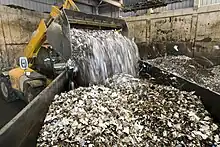

Waste (or wastes) are unwanted or unusable materials. Waste is any substance which is discarded after primary use, or is worthless, defective and of no use. A by-product by contrast is a joint product of relatively minor economic value. A waste product may become a by-product, joint product or resource through an invention that raises a waste product's value above zero.
Examples include municipal solid waste (household trash/refuse), hazardous waste, wastewater (such as sewage, which contains bodily wastes (feces and urine) and surface runoff), radioactive waste, and others.
Definitions
What constitutes waste depends on the eye of the beholder; one person's waste can be a resource for another person.[1] Though waste is a physical object, its generation is a physical and psychological process.[1] In the United States, people who work with waste professionally use four terms – trash, garbage, refuse, and rubbish; trash is dry, garbage is wet, refuse is both, and rubbish is refuse plus construction and demolition debris.[2] The definitions used by various agencies are as below.
United Nations Environment Program
According to the Basel Convention on the Control of Transboundary Movements of Hazardous Wastes and Their Disposal of 1989, Art. 2(1), "'Wastes' are substance or objects, which are disposed of or are intended to be disposed of or are required to be disposed of by the provisions of national law".[3]
United Nations Statistics Division
The UNSD Glossary of Environment Statistics[4] describes waste as "materials that are not prime products (that is, products produced for the market) for which the generator has no further use in terms of his/her own purposes of production, transformation or consumption, and of which he/she wants to dispose. Wastes may be generated during the extraction of raw materials, the processing of raw materials into intermediate and final products, the consumption of final products, and other human activities. Residuals recycled or reused at the place of generation are excluded."
European Union
Under the Waste Framework Directive 2008/98/EC, Art. 3(1), the European Union defines waste as "an object the holder discards, intends to discard or is required to discard."[5] For a more structural description of the Waste Directive, see the European Commission's summary.
Types
There are many waste types defined by modern systems of waste management, notably including:
- Municipal waste includes household waste, commercial waste, and demolition waste
- Hazardous waste includes industrial waste
- Biomedical waste includes clinical waste
- Special hazardous waste includes radioactive waste, explosive waste, and electronic waste (e-waste)
Reporting
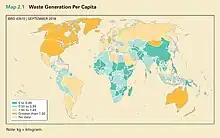
There are many issues that surround reporting waste. It is most commonly measured by size or weight, and there is a stark difference between the two. For example, organic waste is much heavier when it is wet, and plastic or glass bottles can have different weights but be the same size.[6] On a global scale it is difficult to report waste because countries have different definitions of waste and what falls into waste categories, as well as different ways of reporting. Based on incomplete reports from its parties, the Basel Convention estimated 338 million tonnes of waste was generated in 2001.[7] For the same year, OECD estimated 4 billion tonnes from its member countries.[8] Despite these inconsistencies, waste reporting is still useful on a small and large scale to determine key causes and locations, and to find ways of preventing, minimizing, recovering, treating, and disposing waste.
Costs
Environmental costs
Inappropriately managed waste can attract rodents and insects, which can harbour gastrointestinal parasites, yellow fever, worms, the plague and other conditions for humans, and exposure to hazardous wastes, particularly when they are burned, can cause various other diseases including cancers. [9]Toxic waste materials can contaminate surface water, groundwater, soil, and air which causes more problems for humans, other species, and ecosystems.[10] Waste treatment and disposal produces significant green house gas (GHG) emissions, notably methane, which are contributing significantly to global warming.[7] As global warming and co2 emission increase, soil begins to become a larger carbon sink and will become increasingly volatile for our plant life. [11]
Social costs
Waste management is a significant environmental justice issue. Many of the environmental burdens cited above are more often borne by marginalized groups, such as racial minorities, women, and residents of developing nations. NIMBY (not in my back yard) is the opposition of residents to a proposal for a new development because it is close to them.[12] However, the need for expansion and siting of waste treatment and disposal facilities is increasing worldwide. There is now a growing market in the transboundary movement of waste, and although most waste that flows between countries goes between developed nations, a significant amount of waste is moved from developed to developing nations.[13]
Economic costs
The economic costs of managing waste are high, and are often paid for by municipal governments;[14] money can often be saved with more efficiently designed collection routes, modifying vehicles, and with public education. Environmental policies such as pay as you throw can reduce the cost of management and reduce waste quantities. Waste recovery (that is, recycling, reuse) can curb economic costs because it avoids extracting raw materials and often cuts transportation costs. "Economic assessment of municipal waste management systems – case studies using a combination of life-cycle assessment (LCA) and life-cycle costing (LCC)".[15] The location of waste treatment and disposal facilities often reduces property values due to noise, dust, pollution, unsightliness, and negative stigma. The informal waste sector consists mostly of waste pickers who scavenge for metals, glass, plastic, textiles, and other materials and then trade them for a profit. This sector can significantly alter or reduce waste in a particular system, but other negative economic effects come with the disease, poverty, exploitation, and abuse of its workers.[16]
Affecting communities
People in developing countries suffer from contaminated water and landfills caused by unlawful government policies that allow first-world countries and companies to transport their trash to their homes and oftentimes near bodies of water. Those same governments do not use any waste trade profits to create ways to manage landfills or clean water sources. Photographer Kevin McElvaney[17] documents the world’s biggest e-waste dump called Agbogbloshie in Accra, Ghana, which used to be a wetland. The young men and children that work in Agbogbloshie smash devices to get to the metals, obtain burns, eye damage, lung and back problems, chronic nausea, debilitating headaches, and respiratory problems and most workers die from cancer in their 20s (McElvaney)[18]. In McElvaney’s photos, kids in fields burning refrigerators and computers with blackened hands and trashed clothes and animals, such as cows with open wounds, in the dumpsite. There are piles of waste used as makeshift bridges over lakes, with metals and chemicals just seeping into the water and groundwater that could be linked to homes' water systems. The same unfortunate situation and dumps/landfills can be seen in similar countries that are considered the third world, such as other West African countries and China. Many Advocating for waste management, stop waste trade, create wastewater treatment facilities, and ultimately provide a clean and accessible water source. The health of all these people in landfills and water are human necessities/rights that are being taken away.[19]
Management
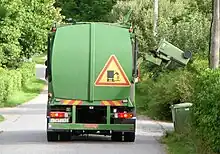
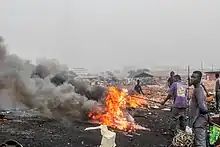
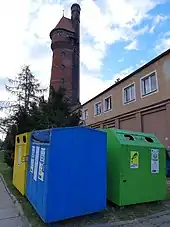
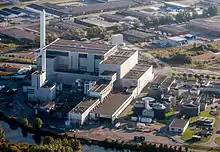
Waste management (or waste disposal) includes the processes and actions required to manage waste from its inception to its final disposal.[20] This includes the collection, transport, treatment and disposal of waste, together with monitoring and regulation of the waste management process and waste-related laws, technologies, economic mechanisms.
Waste can be solid, liquid, or gaseous and each type has different methods of disposal and management. Waste management deals with all types of waste, including industrial, biological, household, municipal, organic, biomedical, radioactive wastes. In some cases, waste can pose a threat to human health.[21] Health issues are associated throughout the entire process of waste management. Health issues can also arise indirectly or directly. Directly, through the handling of solid waste, and indirectly through the consumption of water, soil and food. Waste is produced by [22] human activity, for example, the extraction and processing of raw materials.[23] Waste management is intended to reduce adverse effects of waste on human health, the environment, planetary resources and aesthetics.
Waste management practices are not uniform among countries (developed and developing nations); regions (urban and rural areas), and residential and industrial sectors can all take different approaches.[24]
Proper management of waste is important for building sustainable and liveable cities, but it remains a challenge for many developing countries and cities. A report found that effective waste management is relatively expensive, usually comprising 20%–50% of municipal budgets. Operating this essential municipal service requires integrated systems that are efficient, sustainable, and socially supported.[25] A large portion of waste management practices deal with municipal solid waste (MSW) which is the bulk of the waste that is created by household, industrial, and commercial activity.[26] Measures of waste management include measures for integrated techno-economic mechanisms[27] of a circular economy, effective disposal facilities, export and import control[28][29] and optimal sustainable design of products that are produced.
In the first systematic review of the scientific evidence around global waste, its management and its impact on human health and life, authors concluded that about a fourth of all the municipal solid terrestrial waste is not collected and an additional fourth is mismanaged after collection, often being burned in open and uncontrolled fires – or close to one billion tons per year when combined. They also found that broad priority areas each lack a "high-quality research base", partly due to the absence of "substantial research funding", which motivated scientists often require.[30][31] Electronic waste (ewaste) includes discarded computer monitors, motherboards, mobile phones and chargers, compact discs (CDs), headphones, television sets, air conditioners and refrigerators. According to the Global E-waste Monitor 2017, India generates ~ 2 million tonnes (Mte) of e-waste annually and ranks fifth among the e-waste producing countries, after the US, P.R. China, Japan and Germany.[32]Wastewater facilities
Wastewater treatment facilities remove pollutants and contaminants physically and chemically to clean water to be returned to society. The South Gippsland Water organization breaks down the three steps of waste-water treatment. The primary treatment is to sift through the water to remove large solids to leave oils and small particles in the water. Secondary treatment to dissolve/remove oils, particles, and micro-organisms from the water to be prepared for tertiary treatment to chemically disinfect the water with chlorine or with UV light. “For most industrial applications, a 150,000 GPD capacity WWTS would cost an estimated $500,000 to $1.5 million inclusive of all necessary design, engineering, equipment, installation, and startup”[33]. With such a simple solution that has been proven to clean our water to be reused and is relatively inexpensive, there is no excuse why there should not be a waste-water treatment facility in every country, every state, and every town.
Benefits
“Right now, according to a Nasa-led study, many of the world’s freshwater sources are being drained faster than they are being replenished. The water table is dropping all over the world. There’s not an infinite supply of water”.[34] There is a need to preserve every resource, every finite water source that we do have left to maintain our lives and lifestyles. Able countries helping under-developed countries with their creation of wastewater treatments benefits society. With the addition of wastewater treatment facilities with spending a few million dollars and infrastructure to clean our areas and freshwater to reuse instead of over-using our land and water supply, which would be the greatest cost. Another cost of not adding wastewater treatments in countries is that people have no choice but to clean with, cook with, or drink the contaminated water which has caused millions of disease cases and deaths. “Between 400,000 and 1 million people die each year in developing countries because of diseases caused by mismanaged waste, estimates poverty charity Tearfund”[35]. Society has the means to decrease or even eliminate this way of death and save millions of lives by providing the simple human necessity of clean water.
Utilization
Resource recovery
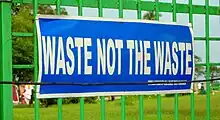
Resource recovery is using wastes as an input material to create valuable products as new outputs. The aim is to reduce the amount of waste generated, thereby reducing the need for landfill space, and optimising the values created from waste.[36] Resource recovery delays the need to use raw materials in the manufacturing process. Materials found in municipal solid waste, construction and demolition waste,[37] commercial waste and industrial wastes can be used to recover resources for the manufacturing of new materials and products. Plastic, paper, aluminium, glass and metal are examples of where value can be found in waste.
Resource recovery goes further than just the management of waste. Resource recovery is part of a circular economy, in which the extraction of natural resources and generation of wastes are minimised, and in which materials and products are designed more sustainably for durability, reuse, repairability, remanufacturing and recycling.[38] Life-cycle analysis (LCA) can be used to compare the resource recovery potential of different treatment technologies.
Resource recovery can also be an aim in the context of sanitation. Here, the term refers to approaches to recover the resources that are contained in wastewater and human excreta (urine and feces). The term "toilet resources" has come into use recently.[39] Those resources include: nutrients (nitrogen and phosphorus), organic matter, energy and water. This concept is also referred to as ecological sanitation. Separation of waste flows can help make resource recovery simpler. Examples include keeping urine separate from feces (as in urine diversion toilets) and keeping greywater and blackwater separate in municipal wastewater systems.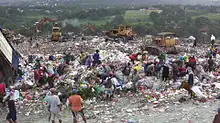
Energy recovery
Energy recovery from waste is using non-recyclable waste materials and extracting from it heat, electricity, or energy through a variety of processes, including combustion, gasification, pyrolyzation, and anaerobic digestion.[40] This process is referred to as waste-to-energy.
There are several ways to recover energy from waste. Anaerobic digestion is a naturally occurring process of decomposition where organic matter is reduced to a simpler chemical component in the absence of oxygen.[40] Incineration or direct controlled burning of municipal solid waste to reduce waste and make energy. Secondary recovered fuel is the energy recovery from waste that cannot be reused or recycled from mechanical and biological treatment activities.[40] Pyrolysis involves heating of waste, with the absence of oxygen, to high temperatures to break down any carbon content into a mixture of gaseous and liquid fuels and solid residue.[40] Gasification is the conversion of carbon rich material through high temperature with partial oxidation into a gas stream.[40] Plasma arc heating is the very high heating of municipal solid waste to temperatures ranging from 3,000 to 10,000 °C, where energy is released by an electrical discharge in an inert atmosphere.[40]
Using waste as fuel can offer important environmental benefits. It can provide a safe and cost-effective option for wastes that would normally have to be dealt with through disposal.[40] It can help reduce carbon dioxide emissions by diverting energy use from fossil fuels, while also generating energy and using waste as fuel can reduce the methane emissions generated in landfills by averting waste from landfills.[40]
There is some debate in the classification of certain biomass feedstock as wastes. Crude Tall Oil (CTO), a co-product of the pulp and papermaking process, is defined as a waste or residue in some European countries when in fact it is produced “on purpose” and has significant value add potential in industrial applications. Several companies use CTO to produce fuel,[41] while the pine chemicals industry maximizes it as a feedstock “producing low-carbon, bio-based chemicals” through cascading use.[42]
Education and awareness
Education and awareness in the area of waste and waste management is increasingly important from a global perspective of resource management. The Talloires Declaration is a declaration for sustainability concerned about the unprecedented scale and speed of environmental pollution and degradation, and the depletion of natural resources. Local, regional, and global air pollution; accumulation and distribution of toxic wastes; destruction and depletion of forests, soil, and water; depletion of the ozone layer and emission of "green house" gases threaten the survival of humans and thousands of other living species, the integrity of the earth and its biodiversity, the security of nations, and the heritage of future generations. Several universities have implemented the Talloires Declaration by establishing environmental management and waste management programs, e.g. the waste management university project. University and vocational education are promoted by various organizations, e.g. WAMITAB and Chartered Institution of Wastes Management.
Gallery
 Vegetable waste being dumped in a market in Hyderabad
Vegetable waste being dumped in a market in Hyderabad Weapon scraps
Weapon scraps Agobox; Bio-medical Waste
Agobox; Bio-medical Waste
 Waste collected in a tricycle
Waste collected in a tricycle.jpg.webp) Shacks and littering by illegal immigrants in South Africa
Shacks and littering by illegal immigrants in South Africa used cigarette boxes
used cigarette boxes Recycling point at the Gdańsk University of Technology
Recycling point at the Gdańsk University of Technology Containers for selective waste collection at the Gdańsk University of Technology
Containers for selective waste collection at the Gdańsk University of Technology
See also
- Biological hazard
- Chemical hazards
- Environmental dumping
- Fly-tipping
- Garbage truck
- Global waste trade
- Human waste
- List of waste management acronyms
- Litter
- Midden
- Recycling
- Waste Atlas
- Waste by country
- Waste collection
- Waste converter
- Waste management
References
- 1 2 Doron, Assa. (2018). Waste of a Nation : Garbage and Growth in India. Harvard University Press. ISBN 978-0-674-98060-0. OCLC 1038462465.
- ↑ Rathje, William L. (2001). Rubbish! : the archaeology of garbage. University of Arizona Press. ISBN 978-0-8165-2143-2. OCLC 1090324165.
- ↑ “Basel Convention.” 1989. "Basel Convention Home Page" (PDF). Archived (PDF) from the original on 2017-05-16. Retrieved 2017-05-27.
- ↑ Glossary of Environment Statistics Archived 2013-01-04 at the Wayback Machine. 1997. UNSD. Updated web version 2001.
- ↑ "Directive 2008/98/EC of the European Parliament and of the Council of 19 November 2008 on waste and repealing certain Directives (Text with EEA relevance)". europa.eu. 22 November 2008.
- ↑ "Solid Waste Management." 2005. United Nations Environment Programme. Chapter III: Waste Quantities and Characteristics, 31-38. unep.or.jp Archived 2009-10-22 at the Wayback Machine
- 1 2 “International Waste Activities.” 2003. U.S. Environmental Protection Agency. 12 Oct 2009. epa.gov Archived 2009-10-16 at the Wayback Machine
- ↑ "Improving Recycling Markets." OECD Environment Program. Paris: OECD, 2006. oecd.org Archived 2015-09-24 at the Wayback Machine
- ↑ Ferronato, Navarro; Torretta, Vincenzo (2019). "Waste Mismanagement in Developing Countries: A Review of Global Issues". International Journal of Environmental Research and Public Health. 16 (6): 1060. doi:10.3390/ijerph16061060. PMC 6466021. PMID 30909625.
- ↑ Diaz, L. et al. Solid Waste Management, Volume 2. UNEP/Earthprint, 2006.
- ↑ Kirschbaum, Miko U.F. (2000-01-01). "Will changes in soil organic carbon act as a positive or negative feedback on global warming?". Biogeochemistry. 48 (1): 21–51. doi:10.1023/A:1006238902976. ISSN 1573-515X. S2CID 97491270.
- ↑ Wolsink, M. "Entanglement of interests and motives: Assumptions behind the NIMBY-theory on Facility Siting." Urban Studies 31.6 (1994): 851-866.
- ↑ Ray, A. "Waste management in developing Asia: Can trade and cooperation help?" The Journal of Environment & Development 17.1 (2008): 3-25.
- ↑ “Muck and brass: The waste business smells of money.” The Economist. 2009 02 28. pp. 10-12.
- ↑ Journal of Cleaner Production 13 (2005): 253-263.
- ↑ Wilson, D.C.; Velis, C.; Cheeseman, C. "Role of informal sector recycling in waste management in developing countries." Habitat International 30 (2006): 797-808.
- ↑ "Agbogbloshie: the world's largest e-waste dump – in pictures". The Guardian. 2014-02-27. ISSN 0261-3077. Retrieved 2021-11-11.
- ↑ "Agbogbloshie: the world's largest e-waste dump – in pictures". The Guardian. 2014-02-27. ISSN 0261-3077. Retrieved 2021-11-11.
- ↑ "Agbogbloshie: the world's largest e-waste dump – in pictures". The Guardian. 2014-02-27. ISSN 0261-3077. Retrieved 2021-11-11.
- ↑ "United Nations Statistics Division – Environment Statistics". unstats.un.org. Archived from the original on 17 March 2017. Retrieved 3 March 2017.
- ↑ "Editorial Board/Aims & Scope". Waste Management. 34 (3): IFC. March 2014. doi:10.1016/S0956-053X(14)00026-9.
- ↑ Giusti, L. (2009-08-01). "A review of waste management practices and their impact on human health". Waste Management. 29 (8): 2227–2239. doi:10.1016/j.wasman.2009.03.028. ISSN 0956-053X. PMID 19401266. Archived from the original on 25 November 2018. Retrieved 4 December 2020.
- ↑ "United Nations Statistics Division - Environment Statistics". unstats.un.org. Archived from the original on 1 December 2017. Retrieved 3 March 2017.
- ↑ Davidson, Gary (June 2011). "Waste Management Practices: Literature Review" (PDF). Dalhousie University – Office of Sustainability. Archived (PDF) from the original on 1 February 2012. Retrieved 3 March 2017.
- ↑ "Solid Waste Management". World Bank. Archived from the original on 30 September 2020. Retrieved 2020-09-28.
- ↑ "Glossary of environmental and waste management terms". Handbook of Solid Waste Management and Waste Minimization Technologies. Butterworth-Heinemann. 2003. pp. 337–465. doi:10.1016/B978-075067507-9/50010-3. ISBN 9780750675079.
- ↑ Gollakota, Anjani R. K.; Gautam, Sneha; Shu, Chi-Min (1 May 2020). "Inconsistencies of e-waste management in developing nations – Facts and plausible solutions". Journal of Environmental Management. 261: 110234. doi:10.1016/j.jenvman.2020.110234. ISSN 0301-4797. PMID 32148304. S2CID 212641354. Archived from the original on 20 September 2021. Retrieved 27 February 2021.
- ↑ Elegba, S. B. (2006). "Import/export control of radioactive sources in Nigeria". Safety and security of radioactive sources: Towards a global system for the continuous control of sources throughout their life cycle. Proceedings of an international conference. Archived from the original on 20 September 2021. Retrieved 27 February 2021.
- ↑ "E –Waste Management through Regulations" (PDF). International Journal of Engineering Inventions. Archived (PDF) from the original on 16 July 2021. Retrieved 27 February 2021.
- ↑ "Health crisis: Up to a billion tons of waste potentially burned in the open every year". phys.org. Archived from the original on 25 January 2021. Retrieved 13 February 2021.
- ↑ Cook, E.; Velis, C. A. (6 January 2021). "Global Review on Safer End of Engineered Life". Global Review on Safer End of Engineered Life. Archived from the original on 22 February 2021. Retrieved 13 February 2021.
- ↑ R. Dhana, Raju (2021). "Waste Management in India – An Overview" (PDF). United International Journal for Research & Technology (UIJRT). 02 (7): 175–196. eISSN 2582-6832. Archived (PDF) from the original on 24 June 2021. Retrieved 21 June 2021.
- ↑ "How Much Does an Industrial Water Treatment System Cost?". Samco Tech. 2017-09-22. Retrieved 2021-11-11.
- ↑ Smedley, Tim. "Is the world running out of fresh water?". www.bbc.com. Retrieved 2021-11-11.
- ↑ "This is what the world's waste does to people in poorer countries". World Economic Forum. Retrieved 2021-11-11.
- ↑ Iacovidou, Eleni; Millward-Hopkins, Joel; Busch, Jonathan; Purnell, Philip; Velis, Costas A.; Hahladakis, John N.; Zwirner, Oliver; Brown, Andrew (2017-12-01). "A pathway to circular economy: Developing a conceptual framework for complex value assessment of resources recovered from waste". Journal of Cleaner Production. 168: 1279–1288. doi:10.1016/j.jclepro.2017.09.002. ISSN 0959-6526.
- ↑ Miller, Norman (2021-12-16). "The industry creating a third of the world's waste". www.bbc.com. Retrieved 2022-01-02.
{{cite web}}: CS1 maint: url-status (link) - ↑ Velenturf, Anne P. M.; Archer, Sophie A.; Gomes, Helena I.; Christgen, Beate; Lag-Brotons, Alfonso J.; Purnell, Phil (2019-11-01). "Circular economy and the matter of integrated resources". Science of the Total Environment. 689: 963–969. Bibcode:2019ScTEn.689..963V. doi:10.1016/j.scitotenv.2019.06.449. ISSN 0048-9697. PMID 31280177.
- ↑ "The Sanitation Economy". Toilet Board Coalition. 26 March 2018.
- 1 2 3 4 5 6 7 8 IGD (2007). "Energy Recovery and Disposal". Archived from the original on 2014-04-07.
- ↑ "Biofuels: Wasted Energy". Oliver, Christian, Financial Times. April 15, 2014. Retrieved 2014-07-03.
- ↑ "Crude tall oil feed stocks cannot be considered 'waste'". Moran, Kevin, Financial Times. April 30, 2014. Retrieved 2014-07-03.
External links
| Wikiquote has quotations related to: Waste |
| Look up waste or wastefulness in Wiktionary, the free dictionary. |
 Media related to Waste at Wikimedia Commons
Media related to Waste at Wikimedia Commons- Waste at Curlie
- Cambio verde: waste-food exchange project in Curitiba, Brazil
- Resource Productivity and Waste at the OECD

